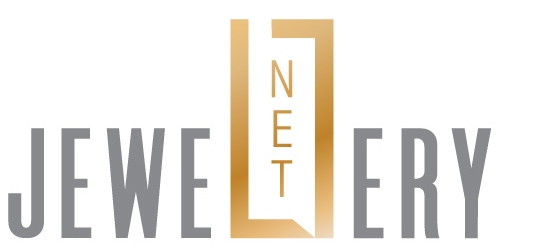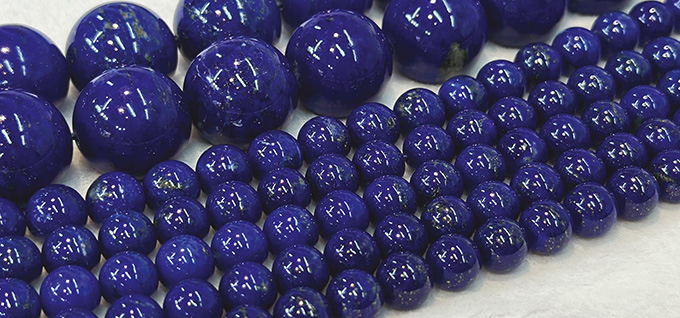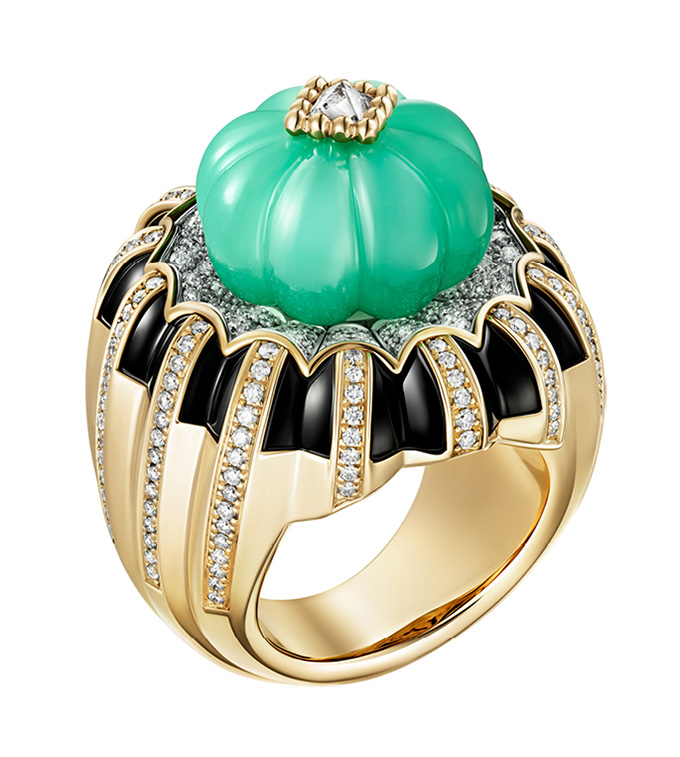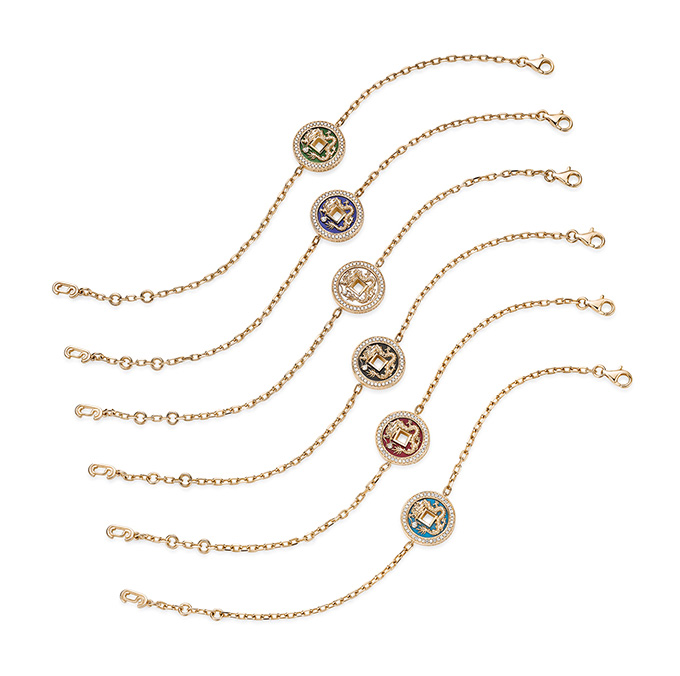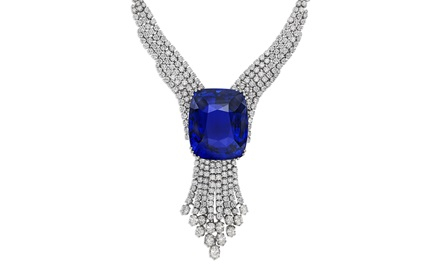Opaque gemstones play a prominent role in jewellery design. Rich in colour and history, these gems resonate with modern consumers seeking beauty and a meaningful connection to their jewellery.
This article first appeared in the GEMSWORLD 2025.
Opaque gemstones have captivated jewellery enthusiasts for centuries, thanks to their full-bodied colours and associated symbolic meaning.
An opaque gemstone is a type of gem that does not allow any light to pass through, resulting in a high-colour density appearance. Examples include turquoise, onyx, malachite, agate and lapis lazuli, among others, which are celebrated for their vibrant hues and intricate patterns.
According to industry players, buyers are paying more attention to coloured gemstones, including opaque varieties, amid a slowdown in the diamond market. This is part of a wider trend towards personalisation, versatility and emotional value.
Luxury jewellery brands are likewise introducing a greater variety of contemporary designs with opaque gems as scintillating accents or as eye-catching centrepieces. Malachite, in particular, has been prominently featured in high-end jewellery collections, adding a touch of modern elegance and vitality to the pieces with its distinctive deep green colour and intricate patterns.
For instance, Van Cleef & Arpels’ Pâquerette Collection features three striking rings adorned with different combinations of ornamental stones, namely blue turquoise with bright red coral, deep onyx with verdant malachite, and blue agate with white mother-of-pearl.
Italian jeweller Roberto Coin, for its part, celebrated opaque gems in latest additions to its Princess Flower Collection. Inspired by floral decorations in Venetian palaces, the collection features 18-karat gold rings, bracelets, earrings and pendants set with diamonds and a variety of opaque gems like lapis lazuli, turquoise, malachite and black jade.
Solid impact
Opaque gemstones are steadily gaining traction in the jewellery industry as consumers continue to seek jewellery pieces that represent a connection to their heritage, aspirations or cherished memories. “There is a shift in the meaning behind owning a piece of jewellery. It is no longer just about adornment. Clients want pieces that serve a purpose, offering healing or emotional support,” said Hong Kong-based jewellery designer Chantel Shafie.
In 2024, Shafie unveiled the Eternal Dragon Collection, which merges traditional Chinese themes with contemporary design elements. Each piece in the collection centres around a dragon and auspicious cloud motifs, and is adorned with diamonds and inlaid with one of six selective ornamental stones: White mother-of-pearl, onyx, jade, red jasper, turquoise and lapis lazuli. These gems are believed to promote emotional balance, strength, harmony, prosperity, energy, protection and wisdom. The designer explained, “My approach to jewellery is creating sentimental pieces that hold significance for the wearer and become part of her personal story. This is why I incorporated ornamental stones in The Eternal Dragon Collection.”
Turquoise, for instance, carries a profound meaning for Shafie whose father is Persian. In Persia, now known as Iran, turquoise is called “firoozeh,” which means victory in Farsi, and is celebrated for its beauty as well as its various properties, Shafie added.
Distinct beauty
According to Wong Chunpiu, sourcing manager of Hong Kong gem and jewellery manufacturer Yee On Gems & Jewellery Fty Co Ltd, turquoise, which is marketed both as a gemstone and an ornamental piece, is one of the most popular opaque stones.
A hydrated phosphate mineral composed of copper and aluminium, turquoise bears colours that range from sky blue to subdued greens, depending on the amount of iron and copper it contains.
Wong said Yee On is expanding its offerings of turquoise jewellery to meet rising market demand, which now include beads, cabochons, fancy shapes and carvings.
Meanwhile, Austria-based Iran Türkis casts the spotlight on its extensive selection of green turquoise. First discovered 25 years ago in Turkmenistan and then subsequently in Iran, green turquoise is rare and has exceptional hardness, according to company manager Christoph Meister.
Green turquoise is also favoured for its unmatched colours, he added. While demand is increasing, the supply of green turquoise remains limited. Prices range from EUR 70 (around US$75) to EUR 150 (around US$160) per gram, based on the quality of the stone – specifically its colour and purity.
“Turquoise is challenging to carve as it is a relatively soft material. We work with top carving companies in Germany to produce our hand-carved turquoise featuring motifs such as snakes, leaves, butterflies and seahorses,” said Meister.
Evolving trends
Wong of Yee On and Daniel Tong, director of Hong Kong based gemstone dealer San Wai Gems & Jewellery Fty Co Ltd, observed that the market for opaque gemstones has remained relatively stable over the years. However, prices are on the rise while buyers increasingly prioritise the quality of the gemstones.
“Prices of opaque gemstones are consistently increasing because of the cost of materials and labour,” said Tong. “Buyers from the US and Europe tend to require larger quantities of stones but often prioritise lower quality. By comparison, Southeast Asians purchase in smaller quantities but have a strong preference for quality gems.”
Wong also noted that Chinese buyers, in particular, demand higher-quality gemstones.
Shafie, for her part, said turquoise and lapis lazuli are popular in Western countries and the Middle East. In Asia, onyx and mother-of-pearl are preferred while red jasper and jade are also in high demand.
Meanwhile, Carlo Muniz, co-founder of Singapore-based Alta California & Co, and Stefan Weinz, CEO of German-based Günther Weinz GmbH, both attested to the desirability of red opaque materials such as fire agate and fire opal among Chinese buyers as red is considered an auspicious colour in Chinese culture. This reflects a broader trend of embracing cultural heritage.
Shafie said black gained popularity in 2024 with the emergence of onyx or stones with darker tones in high-end jewellery collections. “Onyx is incredibly versatile. I see onyx jewellery pieces being worn in various occasions, from elegant evenings to relaxed outings,” said Shafie.
Theresa Ling from Hong Kong jewellery manufacturer Omnia Jewellery agreed, adding that the combination of onyx with diamonds is quite trendy.
“Onyx and diamonds create a striking contrast without overshadowing each other. The deep black colour of onyx enhances the brilliance of the diamonds, exuding a sense of elegance. Our clients respond positively to our onyx and diamond necklaces and rings,” said Ling.
